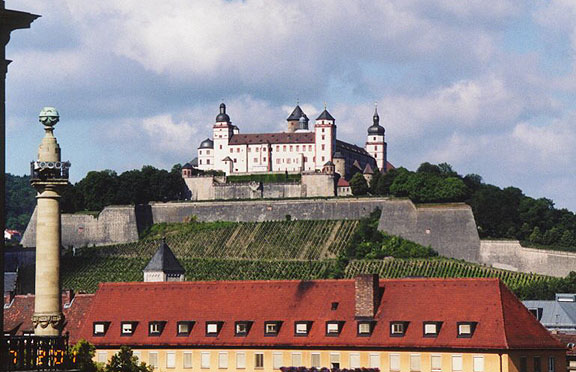

Würzburg

Marienberg
Würzburg, city in southwestern Germany, in Bavaria, on the Main River. It is a railroad junction, an industrial center, and the commercial hub of an agricultural region noted for its vineyards. The leading manufactures of the city include wine and beer, machinery, scientific instruments, paper, pianos, chemicals, and textiles.
colorful parish church
Among the architectural landmarks in Würzburg are a Romanesque cathedral, rebuilt after receiving severe damage in World War II (1939-1945), which contains works by the sculptor Tilman Riemenschneider; Neumünster Church, a chiefly Romanesque structure with an 18th-century baroque facade; a 15th-century stone bridge spanning the Main; the Marienberg fortress atop the Leistenberg, which was the episcopal residence from 1261 to 1720, and which now houses a museum with an extensive collection of Riemenschneider's works; the Julius hospital (founded 1576); and the large rococo episcopal and ducal palace (1720-1744).
the old bridge (1373 - 1543)
The city is the site of a university (1582); the physicist Wilhelm Conrad Roentgen discovered X rays in 1895 while he was a professor in Würzburg. The painter Matthias Grünewald was born and completed much work in the city.
Julius hospital (founded 1576)
its courtyard
Memorial to its benefactors
famous for its wine production
First used as a fortification by Celts, the city was the site of the martyrdom of Saint Kilian, Christian missionary, in 689. Würzburg was founded by Christianized Franks, and in 741 it became an episcopal see.
In front of the New Residence
the statue of the Bishop is looking at
his older residence (Marienberg) in the background.
the new residence
rococo episcopal and ducal palace (1720-1744).
as seen from the garden
the Bishop's crest
in the residence chapel
the Baroque pulpit
the Baroque ceiling
In succeeding centuries the bishops of Würzburg were prominent also as temporal princes, and they controlled a substantial area. The bishopric was secularized in 1801, assigned to Bavaria in 1803, and transferred to Ferdinand III, the dispossessed grand duke of Tuscany, in 1805. It passed to Bavaria in 1815. During World War II the city sustained extensive damage from air raids, but its historic buildings have been reconstructed.
sculpture in the residence garden
Population of Wurzburg (1990 estimate) 125,589.
![]()
![]()